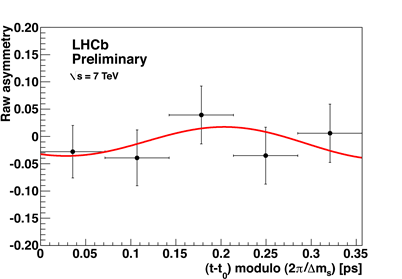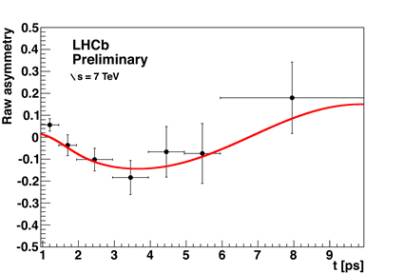In a fascinating world of quantum mechanics the strange beauty particle (matter) B0s turns into its antimatter partner about 3 million million times per second (3*1012), see 15 March 2011 news. Therefore CP violation effects, which are differences between the properties of matter and antimatter, can appear as variations with decay time. A name “time-dependent CP violation” is therefore used.

click the image for higher resolution
The left figure shows the CP asymmetry in the B0d decay into π+π– pair and the right figure shows the asymmetry in the B0s decay into K+K– pair. It can be clearly seen, by comparing time scales of both figures, that the B0d mesons oscillate much slower than the B0s mesons. A new analysis from LHCb has measured the CP asymmetry separated into two components: the difference in the decay rate of B meson and anti-B meson (physicists call it “direct CP violation”) and the quantum-mechanical phase difference between the B meson and anti-B meson decay (“mixing-induced”). These two components appear as a cosine-like and as a sine-like oscillation in the asymmetry plots above.
The results, announced today at the Rencontres de Moriond QCD conference, for the B0d → π+π– decay are Adirπ+π– = 0.11 ± 0.21 ± 0.03 and Amixπ+π– = -0.56 ± 0.17 ± 0.03, meaning the oscillation appears to come mainly from the sine-like component. These are the first measurements of these quantities at a hadron collider, and are consistent with previously published results from other experiments. The results for the B0s → K+K– decay – which are measured for the first time ever – are AdirK+K– = 0.02 ± 0.18 ± 0.04 and AmixK+K– = 0.17 ± 0.18 ± 0.05.
About 2/3 of data taken in 2011 were used in this analysis. The LHCb Collaboration aims to analyse three times more data by the end of this year. This will allow to see if CP violation occurs in the B0s → K+K– decay, and see if the amounts of direct and mixing-induced CP violation are as expected by the Standard Model.
Read more in the LHCb staff page.

